中国传统文化英语
英语作文 中国传统文化
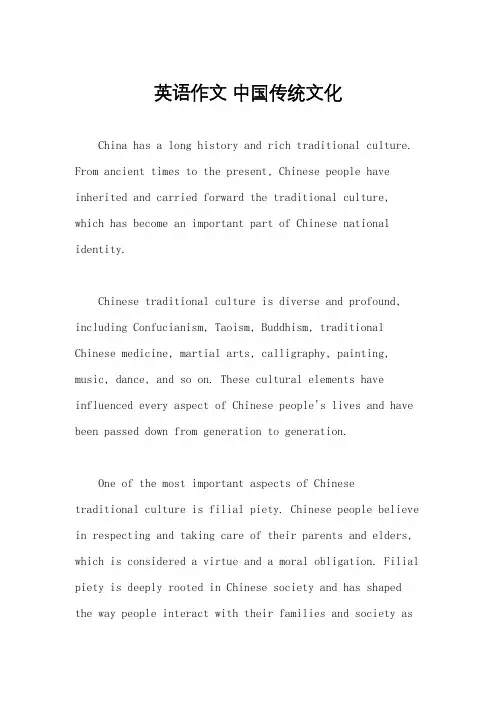
英语作文中国传统文化China has a long history and rich traditional culture. From ancient times to the present, Chinese people have inherited and carried forward the traditional culture, which has become an important part of Chinese national identity.Chinese traditional culture is diverse and profound, including Confucianism, Taoism, Buddhism, traditional Chinese medicine, martial arts, calligraphy, painting, music, dance, and so on. These cultural elements have influenced every aspect of Chinese people's lives and have been passed down from generation to generation.One of the most important aspects of Chinesetraditional culture is filial piety. Chinese people believe in respecting and taking care of their parents and elders, which is considered a virtue and a moral obligation. Filial piety is deeply rooted in Chinese society and has shaped the way people interact with their families and society asa whole.Another important aspect of Chinese traditional culture is the concept of harmony. Chinese people believe in living in harmony with nature, with others, and with oneself. This concept can be seen in traditional Chinese architecture, art, music, and even in the way people communicate with each other.Chinese traditional culture also places a strong emphasis on education. Chinese people value knowledge and learning, and education has always been highly respected in Chinese society. The Chinese education system has a long history and has produced many scholars and intellectuals who have made significant contributions to Chinese culture and society.In conclusion, Chinese traditional culture is a treasure that has been passed down through the ages. It reflects the wisdom, values, and beliefs of the Chinese people and continues to play a significant role in shaping Chinese society today. It is important for Chinese peopleto cherish and preserve their traditional culture, as it is a source of pride and identity for them.。
高中英语 高考英语作文有关中国传统文化的范文4篇带中文翻译
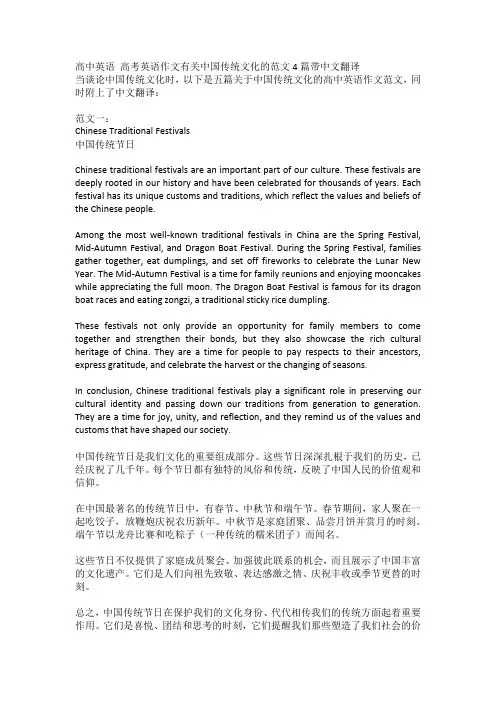
高中英语高考英语作文有关中国传统文化的范文4篇带中文翻译当谈论中国传统文化时,以下是五篇关于中国传统文化的高中英语作文范文,同时附上了中文翻译:范文一:Chinese Traditional Festivals中国传统节日Chinese traditional festivals are an important part of our culture. These festivals are deeply rooted in our history and have been celebrated for thousands of years. Each festival has its unique customs and traditions, which reflect the values and beliefs of the Chinese people.Among the most well-known traditional festivals in China are the Spring Festival, Mid-Autumn Festival, and Dragon Boat Festival. During the Spring Festival, families gather together, eat dumplings, and set off fireworks to celebrate the Lunar New Year. The Mid-Autumn Festival is a time for family reunions and enjoying mooncakes while appreciating the full moon. The Dragon Boat Festival is famous for its dragon boat races and eating zongzi, a traditional sticky rice dumpling.These festivals not only provide an opportunity for family members to come together and strengthen their bonds, but they also showcase the rich cultural heritage of China. They are a time for people to pay respects to their ancestors, express gratitude, and celebrate the harvest or the changing of seasons.In conclusion, Chinese traditional festivals play a significant role in preserving our cultural identity and passing down our traditions from generation to generation. They are a time for joy, unity, and reflection, and they remind us of the values and customs that have shaped our society.中国传统节日是我们文化的重要组成部分。
高考英语作文范文3篇 中国传统文化
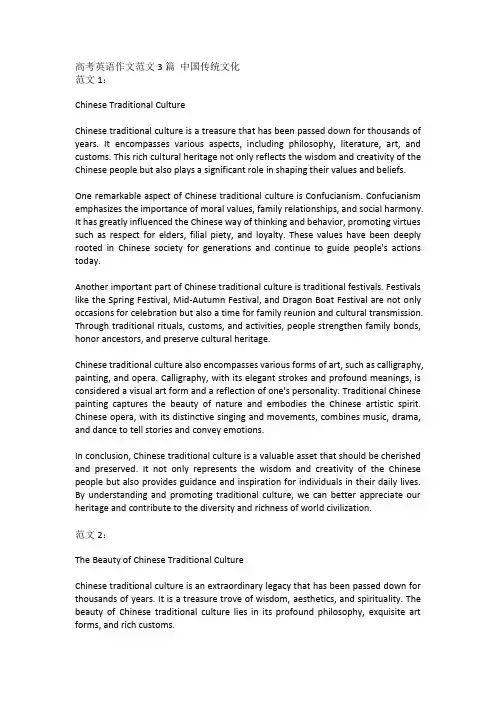
高考英语作文范文3篇中国传统文化范文1:Chinese Traditional CultureChinese traditional culture is a treasure that has been passed down for thousands of years. It encompasses various aspects, including philosophy, literature, art, and customs. This rich cultural heritage not only reflects the wisdom and creativity of the Chinese people but also plays a significant role in shaping their values and beliefs.One remarkable aspect of Chinese traditional culture is Confucianism. Confucianism emphasizes the importance of moral values, family relationships, and social harmony. It has greatly influenced the Chinese way of thinking and behavior, promoting virtues such as respect for elders, filial piety, and loyalty. These values have been deeply rooted in Chinese society for generations and continue to guide people's actions today.Another important part of Chinese traditional culture is traditional festivals. Festivals like the Spring Festival, Mid-Autumn Festival, and Dragon Boat Festival are not only occasions for celebration but also a time for family reunion and cultural transmission. Through traditional rituals, customs, and activities, people strengthen family bonds, honor ancestors, and preserve cultural heritage.Chinese traditional culture also encompasses various forms of art, such as calligraphy, painting, and opera. Calligraphy, with its elegant strokes and profound meanings, is considered a visual art form and a reflection of one's personality. Traditional Chinese painting captures the beauty of nature and embodies the Chinese artistic spirit. Chinese opera, with its distinctive singing and movements, combines music, drama, and dance to tell stories and convey emotions.In conclusion, Chinese traditional culture is a valuable asset that should be cherished and preserved. It not only represents the wisdom and creativity of the Chinese people but also provides guidance and inspiration for individuals in their daily lives. By understanding and promoting traditional culture, we can better appreciate our heritage and contribute to the diversity and richness of world civilization.范文2:The Beauty of Chinese Traditional CultureChinese traditional culture is an extraordinary legacy that has been passed down for thousands of years. It is a treasure trove of wisdom, aesthetics, and spirituality. The beauty of Chinese traditional culture lies in its profound philosophy, exquisite art forms, and rich customs.One of the most remarkable aspects of Chinese traditional culture is its philosophy, which offers profound insights into life and the universe. Concepts such as Yin and Yang, the Five Elements, and the Tao have greatly influenced Chinese thinking and shaped the Chinese worldview. They emphasize the harmony between human beings and nature and the balance between different forces. This philosophical foundation has guided Chinese people in their pursuit of a harmonious and balanced life.Chinese traditional culture is also renowned for its exquisite art forms. Chinese calligraphy, with its graceful strokes and rhythmic movements, is regarded as a visual art and a spiritual practice. Traditional Chinese painting, often depicting landscapes, flowers, and birds, captures the beauty of nature and conveys the artist's emotions. The art of tea, the art of flower arrangement, and the art of porcelain are all examples of the meticulous craftsmanship and aesthetic sensibility of the Chinese people.Furthermore, Chinese traditional culture is deeply rooted in customs and rituals that reflect the values and beliefs of the Chinese people. Festivals such as the Spring Festival, the Lantern Festival, and the Qingming Festival are occasions for family reunion, ancestor worship, and cultural transmission. Customs like the Dragon Boat Festival's dragon boat races and the Mid-Autumn Festival's moon-gazing gatherings not only provide entertainment but also strengthen social bonds and promote cultural identity.In conclusion, the beauty of Chinese traditional culture lies in its profound philosophy, exquisite art forms, and rich customs. It is not only a source of national pride but also a valuable heritage for all of humanity. By appreciating and promoting Chinese traditional culture, we can embrace diversity, foster mutual understanding, and contribute to the harmony and development of the world.范文3:Preserving Chinese Traditional CultureChinese traditional culture is a precious heritage that carries the wisdom and spirit of generations. However, in the face of modernization and globalization, it is crucial to preserve and promote this rich cultural legacy.To preserve Chinese traditional culture, education plays a vital role. Schools should incorporate traditional cultural elements into the curriculum, such as teaching Chinese classics, calligraphy, and traditional arts. By instilling a sense of pride and understanding of their cultural heritage in the younger generation, we can ensure the continuity of Chinese traditional culture.In addition to education, efforts should be made to protect and restore cultural relics and historical sites. These tangible artifacts are essential in preserving the authenticity and integrity of Chinese traditional culture. Governments and organizations should allocate resources to maintain and repair cultural heritage sites, as well as establish strict regulations against their destruction or unauthorized alterations.Furthermore, promoting traditional cultural activities and celebrations is another effective way to preserve Chinese traditional culture. Traditional festivals, such as the Spring Festival and the Dragon Boat Festival, should be celebrated with enthusiasm and authenticity. Cultural performances, exhibitions, and workshops can also be organized to showcase traditional arts, crafts, and customs. By actively participating in these activities, people can deepen their understanding and appreciation of Chinese traditional culture.Moreover, the integration of technology and traditional culture can be explored. Online platforms and digital resources can be utilized to make traditional cultural knowledge more accessible and engaging. Virtual tours of cultural heritage sites, online exhibitions, and interactive learning materials can reach a wider audience and spark interest in Chinese traditional culture among the younger generation.In conclusion, preserving Chinese traditional culture is of great importance in maintaining cultural diversity and promoting cultural harmony. Through education, protection of cultural relics, promotion of traditional activities, and the use of technology, we can ensure that this valuable heritage continues to thrive and enrich the lives of future generations.。
写中国传统文化的英语作文必背的词汇和句子
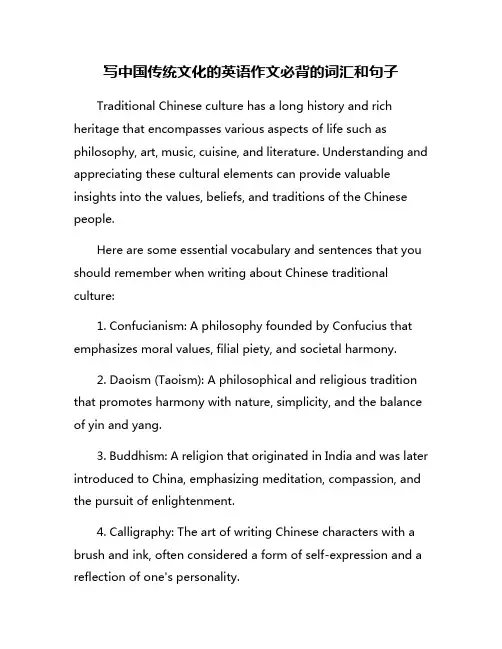
写中国传统文化的英语作文必背的词汇和句子Traditional Chinese culture has a long history and rich heritage that encompasses various aspects of life such as philosophy, art, music, cuisine, and literature. Understanding and appreciating these cultural elements can provide valuable insights into the values, beliefs, and traditions of the Chinese people.Here are some essential vocabulary and sentences that you should remember when writing about Chinese traditional culture:1. Confucianism: A philosophy founded by Confucius that emphasizes moral values, filial piety, and societal harmony.2. Daoism (Taoism): A philosophical and religious tradition that promotes harmony with nature, simplicity, and the balance of yin and yang.3. Buddhism: A religion that originated in India and was later introduced to China, emphasizing meditation, compassion, and the pursuit of enlightenment.4. Calligraphy: The art of writing Chinese characters with a brush and ink, often considered a form of self-expression and a reflection of one's personality.5. Tea ceremony: A traditional Chinese ritual that involves the preparation and serving of tea, symbolizing hospitality, respect, and tranquility.6. Traditional Chinese medicine: A system of healing that includes practices such as acupuncture, herbal remedies, and qigong, based on the concept of balancing the body's energy.7. Silk Road: An ancient trade route that connected China to the Middle East and Europe, facilitating cultural exchange and the spread of goods, ideas, and technologies.8. Four Great Inventions: Refers to the significant technological innovations of ancient China, including papermaking, printing, gunpowder, and the compass.9. Lantern Festival: A traditional Chinese celebration held on the fifteenth day of the Lunar New Year, featuring lantern displays, dragon dances, and the release of lanterns into the sky.10. "Harmony in diversity": A Confucian ideal that emphasizes the importance of unity, cooperation, and mutual respect among individuals and social groups.Sample Sentences:- Confucian ethics play a significant role in shaping Chinese societal values and behavior.- The art of Chinese calligraphy requires precision, discipline, and creativity.- Traditional Chinese cuisine is known for its use of fresh ingredients, subtle flavors, and balanced nutritional principles.- The practice of Tai Chi is a form of martial arts that promotes physical, mental, and spiritual well-being.- Chinese traditional music often features traditional instruments such as the guqin, pipa, and erhu.In conclusion, Chinese traditional culture is a treasure trove of wisdom, beauty, and traditions that have been passed down through generations. By exploring and understanding these cultural elements, we can gain a deeper appreciation of Chinese history, philosophy, and values. Learning about traditional Chinese culture is not only a means of preserving our heritage but also a way of fostering cross-cultural understanding and appreciation in today's globalized world.。
英语作文:中国传统文化 Chinese Traditional Culture
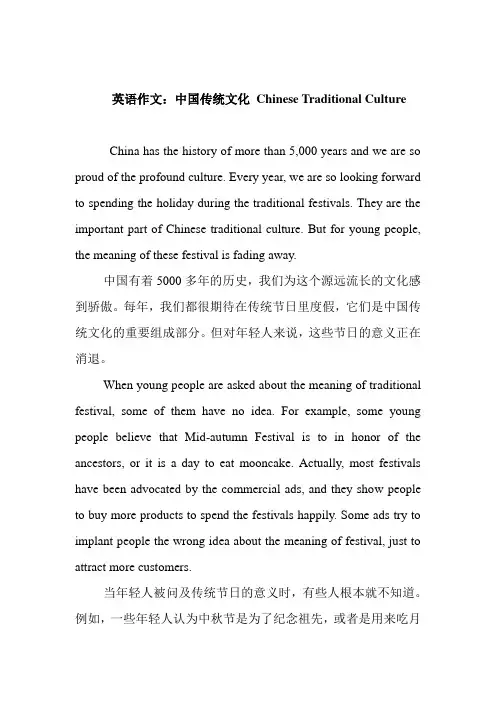
英语作文:中国传统文化Chinese Traditional CultureChina has the history of more than 5,000 years and we are so proud of the profound culture. Every year, we are so looking forward to spending the holiday during the traditional festivals. They are the important part of Chinese traditional culture. But for young people, the meaning of these festival is fading away.中国有着5000多年的历史,我们为这个源远流长的文化感到骄傲。
每年,我们都很期待在传统节日里度假,它们是中国传统文化的重要组成部分。
但对年轻人来说,这些节日的意义正在消退。
When young people are asked about the meaning of traditional festival, some of them have no idea. For example, some young people believe that Mid-autumn Festival is to in honor of the ancestors, or it is a day to eat mooncake. Actually, most festivals have been advocated by the commercial ads, and they show people to buy more products to spend the festivals happily. Some ads try to implant people the wrong idea about the meaning of festival, just to attract more customers.当年轻人被问及传统节日的意义时,有些人根本就不知道。
100个中国传统文化英语名词
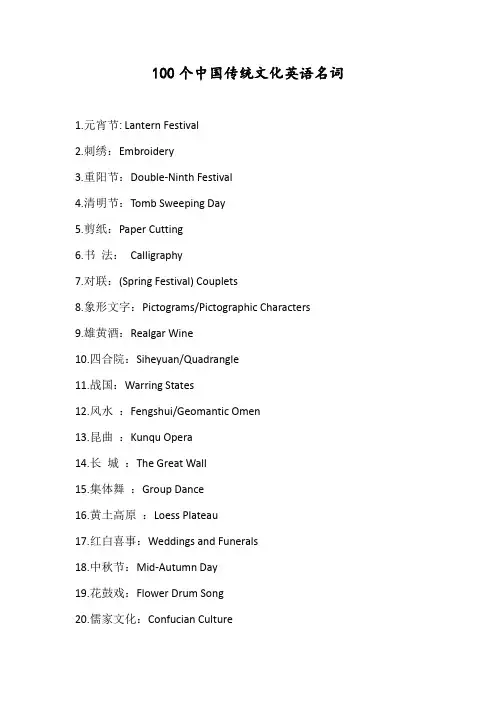
100个中国传统文化英语名词1.元宵节: Lantern Festival2.刺绣:Embroidery3.重阳节:Double-Ninth Festival4.清明节:Tomb Sweeping Day5.剪纸:Paper Cutting6.书法:Calligraphy7.对联:(Spring Festival) Couplets8.象形文字:Pictograms/Pictographic Characters9.雄黄酒:Realgar Wine10.四合院:Siheyuan/Quadrangle11.战国:Warring States12.风水:Fengshui/Geomantic Omen13.昆曲:Kunqu Opera14.长城:The Great Wall15.集体舞:Group Dance16.黄土高原:Loess Plateau17.红白喜事:Weddings and Funerals18.中秋节:Mid-Autumn Day19.花鼓戏:Flower Drum Song20.儒家文化:Confucian Culture21.中国结:Chinese knotting22.古装片:Costume Drama23.武打片:Chinese Swordplay Movie24.元宵:Tangyuan/Sweet Rice Dumpling (Soup)25.越剧:Yue Opera26.火锅:Hot Pot27.江南:South Regions of the Yangtze River28.《诗经》:The Book of Songs29.谜语:Riddle30.《史记》:Historical Records/Records of the Grand Historian31.《红楼梦》:A Dream of Red Mansions32.《西游记》:The Journey to the West33.除夕:Chinese New Year's Eve/Eve of the Spring Festival34.针灸:Acupuncture35.唐三彩:Tri-color Pottery of the Tang Dynasty/ The Tang Tri-colored pottery36.二人转: Errenzhuan37.偏旁:Radical38.孟子:Mencius39.亭/阁:Pavilion/Attic40.黄梅戏:Huangmei Opera41.火药:Gunpowder42.农历:Lunar Calendar43.印/玺:Seal/Stamp44.腊八节:The laba Rice Porridge Festival45.京剧:Beijing Opera/Peking Opera46.秦腔:Crying of Qin People/Qin Opera47.太极拳:TaiChi48.《本草纲目》: Compendium of Materia Medica49.天坛:Altar of Heaven in Beijing50.小吃摊:Snack Bar/Snack Stand51.红双喜:Double Happiness52.文房四宝(笔墨纸砚): The Four Treasure of the Study/Brush,Inkstick,Paper,and Inkstone53.春卷:Spring Roll(s)54.莲藕:Lotus Root55.罗盘:Luopan56.故宫博物院:The Palace Museum57.相声:Cross-talk/Comic Dialogue58.五行:Five Phases59.北京烤鸭: Beijing Roast Duck60.《桃花扇》:The Peach Blossom Fan61.木偶戏:Puppet Show62.敦煌莫高窟:Mogao Caves63.电视小品:TV Sketch/TV Skit64.甲骨文:Oracle Bone Inscriptions65.古筝:Chinese Zither66.二胡:Urheen67.门当户对:Perfect Match/Exact Match68.《水浒》: Water Margin/Outlaws of the Marsh69.除夕:Chinese New Years Eve70.国子监:Imperial Academy71.兵马俑: Cotta Warriors/Terracotta Army72.旗袍:Cheongsam73.指南针:Compass74.泼水节:Water-Splashing Day75.馄饨:Wonton76. 花卷:Steamed Twisted Rolls77.羊肉泡馍:Pita Bread Soaked in Lamb Soup78.冰糖葫芦:A stick of sugar-coated haws (or apples,etc.)79.八宝饭:Eight-Treasure Rice Pudding80.粉丝:Glass Noodles81.豆腐脑:Jellied Bean Curd82.小品:Witty Skits83.孝顺:To Show Filial Obedience84.武术:Wushu(Chinese Martial Arts)85.宣纸:Rice Paper86.衙门:Yamen87.叩头:Kowtow88. 中庸:The Way of Medium(cf. Golden Means)89.牌楼:Pailou(Pai-Loo)90.东坡肉:Dongpo Pork91.中山陵:The Sun Yat-sen Mausoleum92.秦淮河:Qinhuai River93.玄武湖:Xuanwu Lake94.夫子庙:the Confucian Temple95.鸭血粉丝:Duck Blood Fans96.盐水鸭:Yanshuiya, or Salted and Baked Duck97.大煮干丝:Gansi98.小笼包:Steamed Buns99.明孝陵:Ming Tomb100.云锦:Nanjing brocade。
中国的传统文化英语作文
中国的传统文化英语作文China, with its millennia-old history, boasts a cultural heritage that is both profound and diverse. The traditional culture of China is a mosaic of various elements, each withits own unique charm and significance.Philosophy and Religion:At the heart of Chinese culture lies a rich tapestry of philosophical and religious beliefs. Confucianism, Taoism,and Buddhism have shaped the moral and ethical foundations of Chinese society. Confucius taught the importance of social harmony, respect for elders, and the five cardinal relationships. Taoism emphasizes living in harmony with the Tao, or the natural way of the universe. Buddhism, introduced from India, has been integrated into Chinese culture, influencing art, literature, and daily life.Festivals and Celebrations:Chinese festivals are vibrant and colorful, reflecting the country's rich cultural diversity. The Spring Festival, also known as Chinese New Year, is the most important festival, symbolizing family reunion and the start of a new year. The Mid-Autumn Festival is celebrated with mooncakes and lanterns, while the Dragon Boat Festival commemorates the ancient poet Qu Yuan with dragon boat races and zongzi (sticky rice dumplings).Arts and Crafts:Chinese art is renowned for its elegance and intricacy. Calligraphy, painting, and pottery are forms of art that have been honed to a high degree of sophistication. The art of calligraphy is not just writing but a form of expression that captures the essence of the character's meaning. Chinese paintings often depict landscapes, flora, and fauna with a focus on capturing the spirit rather than the physical appearance.Music and Dance:Traditional Chinese music is characterized by its use of unique instruments such as the guzheng, pipa, and erhu. These instruments produce a melodic and serene sound that is often associated with Chinese music. Traditional dances, such asthe fan dance and the lion dance, are performed duringfestivals and special occasions, embodying grace and strength.Cuisine:Chinese cuisine is as diverse as its culture, with eachregion having its own specialties. The art of cooking inChina is not just about taste but also about presentation and the balance of flavors. Dim sum, Peking duck, and hot pot are just a few examples of the culinary delights that have become synonymous with Chinese culture.Language and Literature:The Chinese language, with its complex characters and tonal nature, is a reflection of the country's ancient civilization. Classical Chinese literature, including the works of poetslike Li Bai and Du Fu, as well as the Four Great Classical Novels, has left an indelible mark on world literature.In conclusion, the traditional culture of China is a treasure trove of wisdom, art, and history. It continues to influence and inspire people around the world, offering a glimpse into a civilization that has thrived for thousands of years.。
中国传统文化介绍(英文版)
栏目索引与介绍•当前位置: 主页/•中外文化/中国文化随着中国加入世界贸易组织,中国将进一步对外开放,中国经济与世界经济更加融合。
因此,将中华民族悠久的历史和灿烂的文化介绍给世界各国人民是所有英语爱好者应尽的责任。
开辟这个栏目,就是为了适应对外宣传的需要。
我们将在此介绍中国历史、音乐、绘画、考古、旅游、经济、宗教等方面的情况。
那些从事中国文化教学与研究的师生会在这里找到一些参考资料和英语表达方式。
中国文化知识漫谈(中文)中国文化美国行(新闻报道与背景介绍)Culture Relics文化古迹Travel Features旅游Wushu/Qigong武术与气功Opera/Theatre戏曲Galleries/Museums美术馆与博物馆Peking Opera中国京剧Events/Festivals节日与民俗Local Opera中国地方戏Chinese New Year's Day中国新年来历与24节气Dance Drama and Ballet中国舞剧与芭蕾Traditions of Chinese New Year中国新年除夕习俗Modern Chinese Drama中国话剧Do's and Don'ts of Chinese New Year 中国新年禁忌Acrobatics, Puppet and Shadow Shows杂技、木偶戏与皮影The History of Lion Dance中国舞狮Quyi Performances中国曲艺表演The History of Fireworks中国鞭炮Paintings/Handicrafts绘画与工艺品Lantern Festival元宵节成语典故一 (三国演义、西游记)Brithday of Confucius孔子生日成语典故二Birthday of Mazoo妈祖生日成语典故三Dragon Boat Festival端午节成语典故四Moon Festival中秋节中国古代简史中国文学(包括古文、近代、现代与当代文学以及文化传统,作家传记)中国诗歌英译 (请综合训练中翻译技巧栏目)中国旅游《旅游英语》网络课程中国旅游十大特色中国西藏北京景点天坛中国美食故宫中国十二生肖:12 Taditional Zodiacs M usic音乐RAM HORSE Solo Recordings中国音乐独奏MONKEY ROOSTER CollectedRecordings中国音乐集锦SNAKE DRAGON TraditionalChinese中国传统乐器与音乐InstrumentalmusicDOG PIG Classical Music中国古典音乐OX TIGERRABBIT RAT中国文化知识漫谈(一)文化的含义什么叫文化?《易经》上说:“观乎天文,以察时变,观乎人文,以化成天下。
中国传统文化 Chinese Traditional Culture_英语作文
中国传统文化Chinese Traditional CultureChina has the history of more than 5,000 years and we are so proud of the profound culture. Every year, we are so looking forward to spending the holiday during the traditional festivals. They are the important part of Chinese traditional culture. But for young people, the meaning of these festival is fading away.中国有着5000多年的历史,我们为这个源远流长的文化感到骄傲。
每年,我们都很期待在传统节日里度假,它们是中国传统文化的重要组成部分。
但对年轻人来说,这些节日的意义正在消退。
When young people are asked about the meaning of traditional festival, some of them have no idea. For example, some young people believe that Mid-autumn Festival is to in honor of the ancestors, or it is a day to eat mooncake. Actually, most festivals have been advocated by the commercial ads, and they show people to buy more products to spend the festivals happily. Some ads try to implant people the wrong idea about the meaning of festival, just to attract more customers.当年轻人被问及传统节日的意义时,有些人根本就不知道。
关于中国传统文化英语作文10篇
关于中国传统文化英语作文10篇Traditional Chinese CultureChina, known for its rich history and diverse culture, boasts a traditional culture that has been passed down through generations. In this article, we will explore ten aspects of traditional Chinese culture and its significance. From Confucianism to Chinese cuisine, each topic provides a glimpse into the vibrant tapestry of Chinese traditions.1. ConfucianismConfucianism plays a fundamental role in shaping Chinese society and values. Emphasizing filial piety, respect for elders, and harmony, Confucian teachings promote social order and moral integrity. These principles have greatly influenced Chinese governance, education, and interpersonal relationships.2. TaoismTaoism, another major philosophical system in China, promotes a harmonious coexistence with nature. It emphasizes a simple and balanced life, encouraging individuals to seek inner peace through meditation and self-reflection. The concept of Yin and Yang and the belief in Qi are key tenets of Taoism.3. Chinese CalligraphyChinese calligraphy, appreciated as a high form of visual art, has a history spanning thousands of years. It involves the skilled and rhythmic use of brushes and ink to create expressive characters on paper or silk. Thestrokes and structure of each character convey the artist's emotions and aesthetics.4. Traditional FestivalsChina's traditional festivals are an essential part of its cultural identity. Events like the Spring Festival (Chinese New Year), Dragon Boat Festival, and Mid-Autumn Festival not only celebrate the changing seasons but also provide opportunities for family reunions and cultural exchange. Festivals often include vibrant displays of dragon dances, lanterns, and traditional performances.5. Chinese OperaChinese opera, with its distinct music, singing, and intricate costumes, is a combination of theater, music, and dance. It has a history of over 1,000 years and encompasses different regional styles, such as Peking Opera, Yue Opera, and Kunqu Opera. Chinese opera showcases traditional stories, myths, and historical events, and requires highly skilled performers.6. Martial ArtsMartial arts, known as "Wushu" in Chinese, embodies both physical exercise and philosophical principles. Styles such as Tai Chi and Kung Fu emphasize discipline, concentration, and balance. Practitioners not only develop self-defense skills but also cultivate mental and spiritual strength.7. Traditional Chinese MedicineTraditional Chinese Medicine (TCM) is a holistic and ancient approach to healthcare that encompasses various practices. Acupuncture, herbalmedicine, and Qi Gong are integral parts of TCM. TCM focuses on balancing Yin and Yang, promoting the body's self-healing mechanisms, and maintaining overall well-being.8. Tea CultureTea plays a significant role in Chinese culture, symbolizing hospitality, respect, and tranquility. The art of tea preparation and appreciation dates back thousands of years. Chinese tea ceremonies emphasize mindfulness, simplicity, and the enjoyment of the tea's aroma, color, and taste.9. Feng ShuiFeng Shui, an ancient Chinese practice, aims to create harmonious environments by balancing energy flows. It considers factors such as the placement of furniture, colors, and natural elements to optimize the flow of positive energy. Feng Shui is widely believed to bring good luck, enhance health, and promote prosperity.10. Chinese CuisineChinese cuisine is renowned for its diversity, flavors, and cooking techniques. From fiery Sichuan cuisine to delicate Cantonese dim sum, each regional cuisine represents distinctive flavors, ingredients, and cooking methods. The importance of food in Chinese culture is evident through the practice of family-style dining and the symbolism associated with certain dishes.In conclusion, traditional Chinese culture encompasses a range of practices and beliefs that have shaped Chinese society for centuries. From philosophy to the arts, these aspects reflect Chinese values, customs, and adeep-rooted connection to history. Exploring traditional Chinese culture reveals a wealth of traditions and wisdom that continue to influence and inspire people both within and beyond China.。
- 1、下载文档前请自行甄别文档内容的完整性,平台不提供额外的编辑、内容补充、找答案等附加服务。
- 2、"仅部分预览"的文档,不可在线预览部分如存在完整性等问题,可反馈申请退款(可完整预览的文档不适用该条件!)。
- 3、如文档侵犯您的权益,请联系客服反馈,我们会尽快为您处理(人工客服工作时间:9:00-18:30)。
some kinds of tea
Beijing Opera is very popular in China. It has a history of more than 200 years. During the reign of the Qianlong emperor in the Qing dynasty, Qianlong had an interest in the local opera. In 1790, in order to celebrate his eightieth birthday, he summoned opera troupes (戏班)from different
城市地下空间1001班 张梦薇
Discover the identity forming Chinese cultural symbols that are instantly associated with the unique culture of the region. Every culture has some identity forming symbols that are instantly associated with that culture. The Chinese culture being one full of symbolism has many prominent symbols that can be termed as the cultural symbols of the country.
末
生
净
丑
旦
China,as the very symbol of Chinese craft,it has a long history .Ceramics includes pottery and porcelain.The developement of ceramics is an important part of Chinese culture. China,as one of the four ancient civilizations, made a great contribution to human development and social progress . What's more, the invention and the development of ceramics has more unique significance .The production of ceramic reflects the Chinese great achievements in science and technology ,as well as the beautiful pursuit and shape in many aspects.
பைடு நூலகம்
Tea Beijing Opera
China other symbols
China is the homeland of tea. It is believed that China has tea-shrubs as early as five to six thousand years ago, and human cultivation of teaplants dates back two thousand years. Tea from China, along with her silk and porcelain, began to be known the world over more than a thousand years ago and has since always been an important Chinese export. At present more than forty countries in the world grow tea with Asian countries producing 90% of the world's total output. All tea trees in other countries have their origin directly or indirectly in China.
Terra Cotta Warriors
Great Wall
Panda
Chopsticks
places to perform for him in Beijing.Four famous troupes
from Anhui province remained in Beijing after the celebration. In 1828, A Hubei troupe came to Beijing and often performed together with the Anhui troupes. The two types of singing mixed together and gradually a new type came into being known as Beijing Opera.
